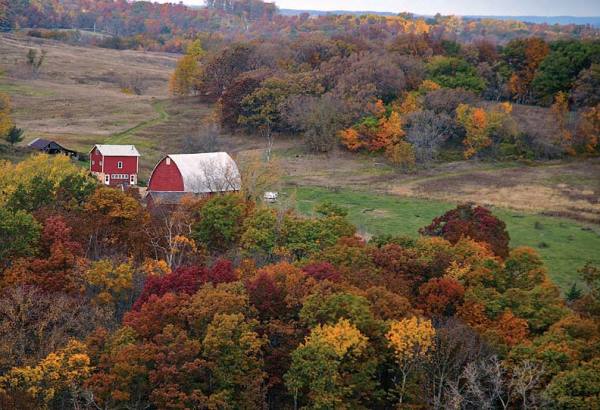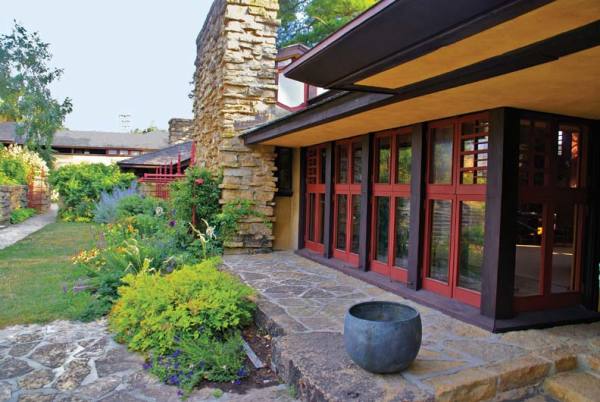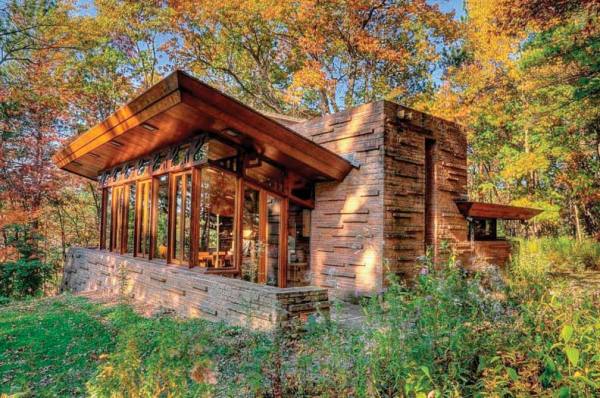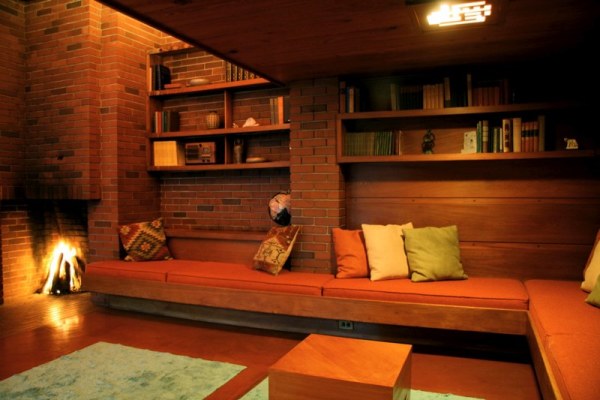The pastoral Spring Green landscape, awash in fall color. Beth McConnell
Follow the curve of the Wisconsin River south of Baraboo, and pretty soon you’ll find yourself in Frank Lloyd Wright country. The great American architect was born in Richland Center and spent much of his childhood in Madison and Spring Green, eventually returning to the latter town to build—and rebuild—his own home and masterwork, Taliesin. Wright designed almost 150 buildings for his home state of Wisconsin, only 60 of which were built. Of these, 43 stand today; while most are still privately owned and not open to the public, some offer regular tours and even the chance to spend the night.
Taliesin
The courtyard at Taliesin. Gwen Schwanke, Courtesy of Taliesin Preservation, Inc.
Wright built his first commission, the Hillside School, in 1887 on the 600-acre estate in Spring Green, where he spent his boyhood summers. In 1911, he returned to build his own home, Taliesin (Welsh for “shining brow”), on the site. The home became his studio, refuge, and training ground; he rebuilt it twice after devastating fires, and he continued to tweak it and other buildings on the estate (including the Hillside School, which he remodeled to serve as the headquarters of his architectural fellowship) throughout his life.
Taliesin is open daily from May through October; the most comprehensive overview can be found on the four-hour estate tour, which traverses the grounds and the interiors of both the Hillside School and Taliesin, culminating with refreshments on Wright’s private terrace.
Madison
Thirty-five miles from Spring Green, you’ll find more Wright buildings in Madison. Tour the Unitarian Meeting House, easily recognized by its towering glass prow, or the posthumously completed Monona Terrace, where Wright’s guiding hand is evident in the building’s curvilinear shape and outdoor connections. Seven privately owned Wright houses remain, too; the easiest to spot on a driving tour are the Jacobs House at 441 Toepfer Ave. and the Eugene A. Gilmore “Airplane House” at 120 Ely Place.
The Seth Peterson Cottage’s expansive windows offer views of Mirror Lake. Kit Hogan
Where to Stay
If you’ve always wanted to call one of Wright’s masterpieces home, you can—at least for the night. The one-bedroom Seth Peterson Cottage on Mirror Lake, built by Wright in 1958, has been available for rentals since 1992. Plan early, though—weekends can fill up more than a year in advance.
See more Frank Lloyd Wright houses you can rent for the night.
Elsewhere in Wisconsin
American System-Built Homes
Milwaukee
Between 1915 and 1917, Wright created six prototype houses in Milwaukee for American System-Built Homes. Like many kit homes of the day, his affordable designs relied on factory-cut materials, assembled on site, to keep costs down. The block of homes is easy to spot on a drive-by tour, or you can peek inside the Model B1 home at 2714 West Burnham during tours on the second and fourth Saturdays of each month.
Annunciation Greek Orthodox Church
Wauwatosa
One of Wright’s last commissions (construction was completed posthumously), this church has a wide, circular shape that pays homage to traditional Greek Orthodox domes while also indulging Wright’s preference for horizontal forms. Tours aren’t given, but the congregation welcomes visitors to regular Sunday services.
The cozy lounge of the Bernard Schwartz House. Courtesy of the Bernard Schwartz House
Bernard Schwartz House
Two Rivers
Also known as Still Bend, this 1939 Usonian house was originally designed by Wright for a Life Magazine article. The 3,000-square-foot brick house incorporates many of the architect’s Usonian hallmarks: cypress paneling, built-in furniture, ribbons of clerestory windows, and “Cherokee Red” concrete floors. Tours are offered about once a month, or you can rent the house for the night.
S.C. Johnson Wax Administration Building
Racine
Built in 1939 and composed of more than 200 shapes and sizes of bricks, the Johnson Wax Building features an impressive open workspace supported by futuristic, toadstool-like columns. Free tours are given daily (reservations required); the building also holds both a gallery and library dedicated to Wright’s work.
Wingspread
Wind Point
The head of S.C. Johnson was so enamored with Wright’s design for his corporate headquarters that he commissioned the architect to design a private house for his family as well. Named for its four wings arranged in a pinwheel shape, the house is anchored by a dramatic 30’ chimney surrounded by three rows of clerestory windows. Now used by The Johnson Foundation as a conference center, Wingspread is open for tours Tuesday through Friday, by appointment.
Frank Lloyd Wright Reading Recommendations
As an Amazon Associate, we earn from qualifying purchases made through affiliate links.
FRANK LLOYD WRIGHT: THE ROOMS Interiors and Decorative Arts by Margo Stipe (Rizzoli 2014) Intimate immersion inside the Prairie houses, Fallingwater, Hollyhock House & more.
FRANK LLOYD WRIGHT PRAIRIE HOUSES by Alan Weintraub (Rizzoli 2006) Interiors and details of over 70 extant buildings of the Prairie School years. How Wright broke from Beaux Arts symmetry to create “a tartan plaid of main spaces and secondary spaces, of public rooms and circulation spaces”—with brilliant results.
THE PRAIRIE SCHOOL: Frank Lloyd Wright and his Midwest Contemporaries by H. Allen Brooks (Norton 2006) From its beginning to its end, Prairie School beyond Wright. Discusses the architects’ various contributions.
HOMETOWN ARCHITECT: The Complete Buildings of Frank Lloyd Wright in Oak Park and River Forest, Illinois by Patrick F. Cannon (Pomegranate 2006) Houses 1887–1913; this book is the pilgrimage documenting 27 Wright houses in Oak Park and River Forest. Photos include interiors.
FRANK LLOYD WRIGHT: THE HOUSES by Alan Weintraub (Rizzoli 2005) From the 1908 Prairie School Robie house in Chicago through his textile-block houses in Los Angeles, and on to Fallingwater and Taliesin West, here are FLW’s residential commissions all in one huge volume.
FRANK LLOYD WRIGHT’S INTERIORS by Thomas A. Heinz (Gramercy Books 2002) Shown are 1,000 interiors, including houses and public and corporate buildings, from throughout Wright’s career. Horizontal lines, natural elements, concrete, and brilliant use of three dimensions.
FRANK LLOYD WRIGHT’S GLASS DESIGNS by Carla Lind (Pomegranate 1995) Innovative design for windows, skylights, and decoration.







